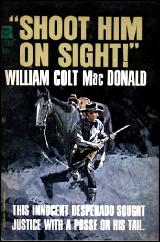Wed 27 Feb 2013
Archived Western Review: “SHOOT HIM ON SIGHT!†– William Colt MacDonald.
Posted by Steve under Reviews , Western Fiction[7] Comments
“SHOOT HIM ON SIGHT!†– William Colt MacDonald. Ace F-389, paperback original; first printing, 1966. Ace ‘Tall Twin’ Western, 2nd printing, 1972; paired with The Troublemaker, by Edwin Booth.

Most westerns, it has been said before, and probably by me, are crime stories. They just happen to take place in the west, and mostly in the late 1800’s. Rustling, bank robberies, feuding between cattlemen and homesteaders and so on, all crime fiction, but unless there’s an element of detective work, Al Hubin does not include it in his bibliography of Crime Fiction, and rightly so. There’s a matter of intent, as well. Most western writers were (and are) writing westerns, and not crime fiction.
And of that aforementioned element of detective work, there is, I have to admit, none in this book. Not that there isn’t a crime, and it’s fairly obvious who the villain is, to the reader that is, and not the narrator of this tale, which is told – and I think this is unusual for westerns, isn’t it? – in first person by John Cardinal, who is on the run from the law.
It seems that to help out his foster parents, he extorted money from a mean, tight-fisted banker and then, knowing that he did wrong, lit out of town. What he doesn’t expect, though, is that his reputation as an outlaw would grow and grow, with WANTED: DEAD OR ALIVE posters going up all across the west. Thinking that this is due to sheer laziness on the part of the law – blaming him when the local sheriffs cannot catch up with their own local desperadoes – the noose that John Cardinal has placed around his own neck grows tighter and tighter. He quickly learns to survive in wilder and wilder towns, trying his utmost to live up to his reputation.
Until he reaches the crookedest town of them all, that is, which is to say Onyxton, a town that’s run by Shel Webster, and whose girl friend is a beautiful dance hall hostess named Topaz. And this is where John Cardinal stops and makes a stand, where he finds out who he is, who’s been behind the problems he’s had in life, and what on earth are guns and ammunition doing in boxes labeled sewing machines being sent to small villages just across the border in Mexico?
A number of MacDonald’s other westerns are listed in Hubin, by the way, many of them featuring a rangeland detective named Gregory Quist, and if I have ever read any, it was so long ago that I do not remember. John Cardinal’s forte, on the other hand, seems merely to be being in the right place at the right time, once he’s decided that Topaz is the girl for him, that is.
Here’s a long quote from pages 112-113, a picturesque scene from Webster’s dance hall:
There’s not a great depth involved here, as you can plainly see, but this is a smoothly told tale that’s not only tasty but a whole lot of fun to read.
July 2004 (slightly revised).
February 28th, 2013 at 1:31 pm
Posted earlier on this blog was my review of BAD MAN’S RETURN
https://mysteryfile.com/blog/?p=14521
which produced a list of all of the books in William Colt MacDonald’s “Three Mesquiteers” series.
And speaking of the Three Mesquiteers, you’ll also find my review of the film THE LAW OF THE 45’S, posted here on this blog:
https://mysteryfile.com/blog/?p=1868
For more on MacDonald himself, and a long list of all his novel-length fiction, here’s his Wikipedia entry:
http://en.wikipedia.org/wiki/William_Colt_MacDonald
which at the bottom has a link to his work for the movies, courtesy of IMDB.
February 28th, 2013 at 5:52 pm
I keep meaning to read this author but I’ve never got around to trying one of his westerns. I’ve been looking through a massive number of WESTERN STORY MAGAZINE pulps and I’ve seen his name quite often. One of these days I’ll read him but time is getting kind of short partner.
I better smile when I say that..
February 28th, 2013 at 6:16 pm
I’ve always thought that William Colt MacDonald was a perfect name for a western writer — and the fact that my grandparents on my mother’s side were named MacDonald had nothing to do with it.
I’ve read quite a few of his western novels and have never come across a bad one, but when asked who my favorite western writers are, I always say Luke Short or Max Brand. I never seem to think of William Colt MacDonald.
March 1st, 2013 at 4:08 am
Steve, you’re right that most Wssterns involve crime and even some detection, but aren’t really Mysteries.
But have you ever read Hockensmith’s books?
In a similar thought-pattern, most Ghost Stories involve detection: identifying the ghost, finding out why s/he haunts up the place, uncovering some old crime or lost whosis… yet they don’t seem like mysteries either.
March 1st, 2013 at 6:03 am
Politics are full of crime without earnest detection, though …
The Doc
March 4th, 2013 at 1:02 pm
Greg Quist isn’t a range detective. He’s a railroad detective.
March 4th, 2013 at 1:52 pm
An important distinction, Jim. Thanks for the correction!